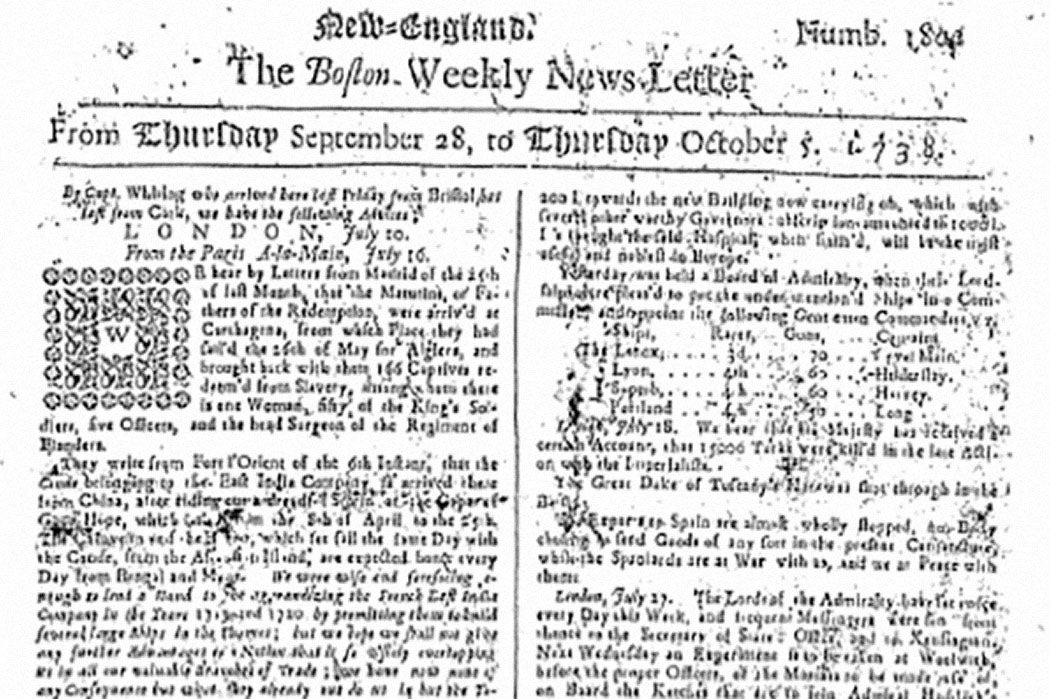Newspapers are a fundamental historical resource. Historians of slavery, for example, rely on early newspaper accounts for some of the only evidence of slave rebellions. But historians know they must be cautious; the “first rough draft of history” is sometimes pretty bogus.
“Early American newspaper printers manufactured and disseminated false reports of plotting in the first half of the eighteenth century,” writes historian Justin Pope. They transformed “fearful rumors” and “conspiracy scares” into sensationalized news, and, “in the process, created conventions for reporting slave unrest during a formative period in the history of the early American press.”
Pope takes on the case of a supposed Nantucket Indian conspiracy in late 1738. The English settler-colonialists on Nantucket Island knew the Wampanoag, beset by colonialist rapaciousness, diseases, and laws, had grievances. So, sparked by a drunken threat from a Native woman, they panicked. To counter the supposed revolt, they marched on their Wampanoag neighbors, hoping to surprise them, and found them asleep.
That false alarm might have been the end of it, but news traveled. In the hands of Boston printer John Draper, owner of the Boston News-Letter, the non-rebellion was turned into an insurrection foiled at the last minute by “one good Indian fellow” who betrayed the conspiracy to the colonialists. Like Boston’s other printers, Draper had already published similar stories about conspiracies and rebellions revealed at the nick of time by an inside source. He just slotted Indians into the role of slaves in the template.
The Native-erasing, slave-based society of the British colonies teetered on the edge of hysteria about revolts of the oppressed.
Draper’s Boston competitors re-printed his fantasy, often verbatim. Within two weeks, John Peter Zenger in New York and young Benjamin Franklin in Philadelphia were retelling the story as well. Sailors carried these newspapers to Britain over the coming months, where other papers picked up the story. Decades later, historians of Nantucket and the whaling industry took these newspapers as truth; as recently as 2000, the non-conspiracy on Nantucket made a list of Atlantic-world insurrections.
Nantucket’s Wampanoag were not slaves, but their dreadful treatment by British settlers clearly haunted the colonists. In particular, British courts had forced more and more Natives into debt-bondage to whaling ship owners, bringing what Pope calls “a new level of suffering to Nantucket’s Native people” as the island’s English elite grew rich off of Indigenous labor.
“Colonists who exploited Native laborers could easily imagine an Indian rebellion,” Pope writes. “Stories of servile conspiracy—the secret plan of a group of oppressed people to obtain their liberty by force—emerged throughout the Americas in places where colonists oppressed subaltern peoples.”
Conspiracy thinking is a perverse mirror: in the mind of the person who engages in it, the conspiracy is always the secret work of others. Typically the narrative of these conspiracy scares involved a loyal servant revealing the plot. Authorities then tortured confessions from supposed participants and executed purported ringleaders, usually with exemplary violence that was supposed to send a message to future conspirators.
Weekly Newsletter
Before 1738, such plots were said to have been foiled in New Jersey, Maryland, Virginia, and South Carolina. There were also cases on Nevis, Antigua, Bermuda, St. Christopher, and the Bahamas. The British empire was rife with rumors of conspiracy and the body parts of their aftermaths, for drawing and quartering was a common execution method. The fact that slave insurrections did take place only added fuel to the fires of panic.
Just a few years after Nantucket’s panic, the New York City Conspiracy of 1741 showed how things might have turned out on the island. Supposedly, poor whites, Catholics, and slaves were planning on burning down the town. Authorities had thirty to forty enslaved peoples and four whites hung or burned at the stake, based only on the probably coerced testimony of a sixteen-year-old indentured servant.
Support JSTOR Daily! Join our new membership program on Patreon today.







